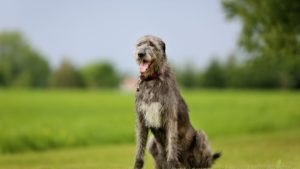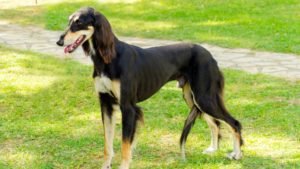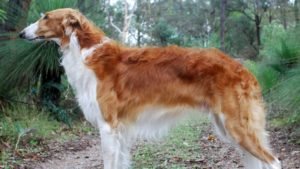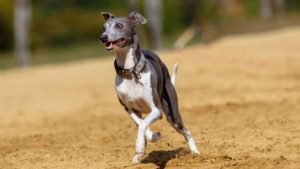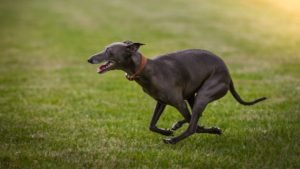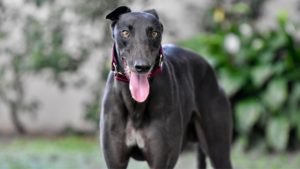Afghan Hound History
The history of the Afghan Hound is not just the tale of a dog breed but a narrative interwoven with human civilization. This majestic breed’s roots trace back to the pre-Christian era in the rugged terrains of Afghanistan. Often dubbed “a king of dogs,” the Afghan Hound possesses an air of nobility that isn’t merely superficial but deeply ingrained in its thousands-of-years-old lineage.
Originally known as “Tazi,” this breed was bred by the Bedouin tribes of Afghanistan. A cursory glance at historical texts and art will reveal the Afghan Hound’s role in the Afghani culture. Its primary function was that of a hunter, not just any game hunter but a big game hunter. Equipped with an agile physique and keen eyesight, Afghan Hounds love to hunt down predators like leopards, keeping them at bay until the hunters can catch up.
Intriguingly, these dogs were utilized for their abilities in the harsh, unforgiving landscape of the Afghan mountains. The Afghan Hound’s long, flowing coat, a hallmark of the breed, was a functional feature. This coat acted as an insulator against the biting cold but also worked as protection from the harsh heat and the rugged terrain.
The first Western acknowledgment of the Afghan Hound came from British military officers stationed near Kabul. The Ghazni Kennel moved to England in 1925. The American Kennel Club recognized the breed a year later, and the Afghan Hound Club of America gained AKC membership in 1940. As such, the Afghan Hound had now garnered global acknowledgment, yet it maintained its majestic and mysterious aura.
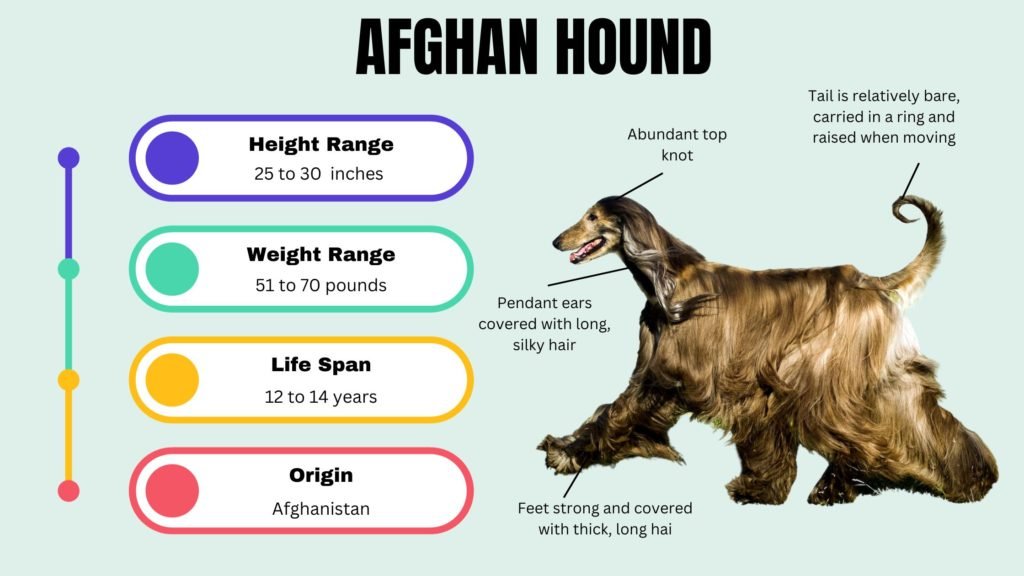
Characteristics
In the world of canines, the Afghan Hound stands out for its unique blend of grace, dignity, and agility. This breed is not just an eye-catcher but a head-turner, thanks to its long, flowing, silky coat. The first thing that often catches one’s attention is this distinctive coat, which, believe it or not, has both form and function.
When it comes to size, Afghan Hounds exhibit a noticeable sexual dimorphism. Males stand at around 27 inches, weighing about 60 pounds, while females measure approximately 25 inches and weigh about 50 pounds. Despite their somewhat delicate appearance, these dogs are sturdy and well-proportioned.
The Afghan’s head is refined and elongated, almost elegantly. Their eyes are dark and almond-shaped, exuding an almost human-like expression of wisdom and mystery. The ears hang close to the head and are covered with long, fine hair.
But the coat is where the real magic happens. The texture is lovely, akin to human hair, and the length can go down to the ground. Grooming such a coat is no small feat; it’s time-consuming and demanding. The coat covers the entire body, the ears, and feet. Its thickness acts as insulation against extreme weather conditions.
Colors can range in a broad spectrum. The American Kennel Club permits all solid colors, although there are preferences for specific combinations. It allows for a wide range of visual appeal, with each Afghan Hound being somewhat unique in its appearance.
While their beauty is awe-inspiring, Afghan Hounds are more than just a pretty face. They’re built for speed and agility, thanks to a deep chest and a strong back, which gives them exceptional lung capacity and stamina.
Life Span
Regarding life expectancy, the Afghan Hound tends to lead a relatively long, healthy life compared to other breeds of its size. Generally, Afghan Hounds live between 12 and 14 years. Some individuals have reached up to 16 years of age. However, this longevity comes with responsibility. Careful attention to various aspects of its health and well-being is essential to ensure that your Afghan Hound reaches its potential for a long life.
Firstly, regular veterinary check-ups are a must. While Afghan Hounds are generally robust, they are susceptible to certain hereditary conditions like cataracts and hip dysplasia. Early detection can make a substantial difference in treatment and quality of life. Vaccinations, flea control, and dental care are essential to their healthcare routine.
Secondly, Diet plays a crucial role. Afghan Hounds are active and energetic, requiring a balanced diet rich in protein, fats, and essential nutrients. It’s vital to consult your vet to understand your dog’s specific dietary needs, which can vary with age, activity level, and health status.
Exercise is essential to maintaining a healthy lifespan. These dogs are naturally athletic, requiring regular training to keep their muscles toned and release pent-up energy. Failure to provide adequate physical and mental stimulation can lead to obesity and related health issues, potentially reducing their life span.
A well-balanced lifestyle that includes proper nutrition, exercise, and healthcare is fundamental in ensuring your Afghan Hound lives a long, happy life.
Family Life
Afghan Hounds are not just pets; they often become integral family members. This breed is known for its aloof yet affectionate demeanor. They may not always be overly demonstrative, but that doesn’t mean they don’t form deep bonds with their human families.
While they may exhibit a certain level of independence, Afghan Hounds are sensitive and thrive on human interaction. They often select a particular family member as their favorite but remain cordial and respectful to all. Families with children will find that the Afghan Hound’s gentle disposition makes them great companions for older kids who can understand the dog’s need for respect and personal space.
Their inherent dignity and calm demeanor also make them an excellent choice for households with seniors. However, it’s worth noting that they require regular exercise to keep them mentally and physically stimulated. Therefore, an active family member should be responsible for this aspect of their care.
Habitat and Diet
The Afghan Hound’s original habitat was the harsh and unforgiving terrains of the Afghan mountains. This background makes them highly adaptable to various living conditions, although they do best with a spacious yard to stretch their legs. However, they can adapt to apartment living provided they get sufficient exercise.
Diet is another crucial aspect of their wellbeing. Afghan Hounds require a diet rich in protein and fat to support their active lifestyle. High-quality commercial dog food often suffices, but consult your vet for specific dietary needs, especially if your Afghan Hound has health issues.
Afghan Hound Temperament
The temperament of the Afghan Hound is often described as dignified, aloof, and even “cat-like” in its independence. However, these traits shouldn’t be mistaken for a lack of affection or loyalty. Afghan Hounds form deep emotional bonds with their owners, often showing a sweet and playful side reserved for their human family.
While they can be wary of strangers, proper socialization from an early age can help them become more approachable. Afghan Hounds are not aggressive but are reserved and selective in their interactions, so early exposure to different people, pets, and environments is crucial.
Afghan Hound Behave With Other Animals
The Afghan Hound’s behavior around other animals can vary significantly depending on the individual dog and its early socialization experiences. By nature, they are sighthounds, bred for hunting, and may have a strong prey drive. This instinct can sometimes make them incompatible with smaller pets like cats or rabbits unless they have been raised together from a young age.
However, Afghan Hounds generally get along well with other dogs, particularly when appropriately socialized. Their aloof nature means they’re not particularly territorial, but early introductions and supervised interactions are advisable to ensure compatibility.
All in all, the Afghan Hound’s behavior with other animals is mainly contingent on its upbringing. They can coexist harmoniously with various other pets with proper training and socialization.
Afghan Hound Coat Color and Grooming
One of the most distinctive features of the Afghan Hound is its long, silky coat. This luxurious fur can come in all colors, including black, red, cream, and brindle. The coat serves a functional purpose in addition to its aesthetic appeal; it protects against the harsh climates from which the breed originates.
Grooming is a significant commitment for Afghan Hound owners. The coat can quickly become matted and tangled if not regularly brushed and maintained. Expect to spend considerable time each week on grooming tasks, including brushing, bathing, and checking for potential skin issues or parasites. Some owners take their Afghan Hounds to professional groomers to manage the coat and ensure it remains in top condition.
Afghan Hound Health
Afghan Hounds are generally healthy dogs, but, like all breeds, they’re prone to certain genetic conditions. Hip dysplasia and cataracts are among the most common issues in this breed. Regular veterinary check-ups and a well-balanced diet can go a long way in ensuring your Afghan Hound stays in good health.
Additionally, they can suffer from allergies that manifest as skin conditions or digestive problems. Always consult your veterinarian if you notice symptoms like scratching, bald patches, or digestive upset. Early detection and treatment of any health issues are essential for long-term well-being.
Afghan Hound Price
The price of an Afghan Hound can vary widely depending on various factors such as lineage, breeder reputation, and geographic location. On average, you can expect to pay anywhere from $1,500 to $3,000 for a well-bred Afghan Hound puppy. Show-quality dogs from distinguished lines can cost significantly more.
It’s crucial to do your research before buying an Afghan Hound. Cheaper is only sometimes better; a low price could indicate a lack of health screenings or subpar living conditions for the puppies. Always visit the breeder, ask for health clearances, and meet at least one of the puppy’s parents to gauge temperament and appearance.
Afghan Hound Trainability
Afghan Hounds are intelligent but possess an independent streak, making training rewarding and challenging. They respond best to training methods that use positive reinforcement and can become stubborn if treated harshly. This breed is sensitive and may become aloof if not handled with care during training sessions.
Consistency is critical when training an Afghan Hound. Due to their intelligence, they can quickly pick up new commands but may ignore them if they feel like it. A well-socialized Afghan Hound is generally more receptive to training, especially when it starts young.
Afghan Hound Care
Caring for an Afghan Hound requires a holistic approach that addresses their physical, emotional, and mental needs. They require a balanced diet to sustain their energy levels and body condition. Exercise is crucial for their physical and psychological well-being; they need a secure space to run and play. Their luxurious coat demands regular grooming to prevent matting and tangles.
Emotionally, Afghan Hounds require a stable and loving environment. They form deep emotional bonds with their families and can become stressed in volatile or neglectful situations. They also need mental stimulation, which can be provided through training, interactive toys, or puzzle feeders.
The Afghan Hound is a unique, elegant breed that makes an excellent companion for the right family. They have specific care needs and are best suited to those who can commit to their exercise, grooming, and emotional well-being. With the proper care, an Afghan Hound can be a loving and loyal member of any family.

